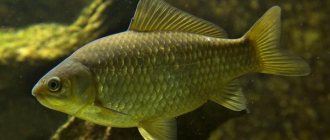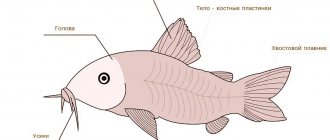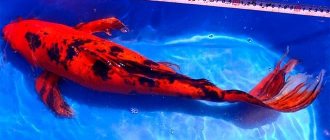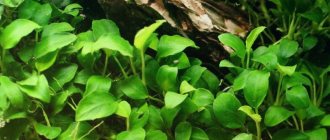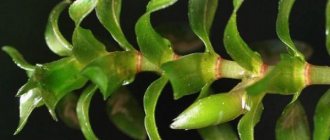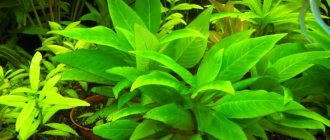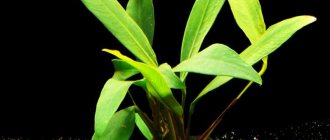Description of culture
Hornwort (ceratophyllum) is a perennial aquatic plant. It has long, stiff stems covered with needle-like green leaves. The shoots grow quickly: within a month they can reach a height of 80-100 centimeters. Small flowers are formed in the internodes, pollination of which occurs in water. After flowering, fruits appear in the form of small nuts.
The natural protection of the plant from being eaten by fish and snails is the cuticle - a fat-like film covering the leaves and stems. However, goldfish can eat hornwort. She eats the tender leaves, leaving the stems behind. Ceratophyllum has no roots. It floats freely in a body of water, or clings to stones and snags with its stem shoots (rhizoids).
Hornwort looks great both on the surface and in the water column. Enlivening the aquarium with its lush greenery.
Hornwort gets its nutrition from water. It should be warm and erect. Otherwise, the plant will begin to shed its lower leaves and press toward the bottom.
Types of Hornwort for aquariums and their features
Hornwort enjoys a reputation as a plant that is almost ideal for beginner aquarists. The reason is that this plant is very easy to grow and does not require any difficult conditions. That is, people who are not yet experienced will be able to easily grow it, with virtually no fear that they will not succeed.
The following types of this plant are common in the aquarium hobby: submerged hornwort, Mexican hornwort, semi-submerged hornwort, Cuban hornwort.
Hornwort submerged
Hornwort submerged
A perennial plant native to North America. Now widespread throughout almost the entire globe. In some regions it creates huge problems, as other plants from water bodies survive quietly. For example, in New Zealand, Egypt and some North American states, grass carps, which love to eat this plant, are specially released into water bodies with Hornwort. However, in some cases, the exact opposite effect was observed - the fish began to destroy other plants, allowing the Hornwort to quietly develop further. Features of this plant:
- Can swim freely without necessarily being attached to the bottom silt.
- The leaves of the plant are dark green in color.
- Stems - with a slightly reddish tint.
- As winter approaches, even while in the aquarium, the submerged Hornwort begins to shed its leaves and prepare for hibernation.
- Other well-known names for this plant are aquarium needles, Ceratophyllum, dark green hornwort.
- Capable of developing in a fairly wide range of temperatures: from 18 to 28 degrees.
- The preferred water parameters are as follows: acidity – 7-7.5, hardness – 6-15.
- The plant does not require any fertilizer, since it usually receives everything it needs thanks to the waste of the fish that are in the same aquarium with it.
The recommended length of daylight hours is fourteen hours. If the lighting is bright enough, the plant can increase in size up to three centimeters within one day!
Mexican Hornwort
Mexican Hornwort
Another name for this species is Ceratophyllum demersum "Mexiko". The homeland of this particular plant was determined very accurately. This is Lake Catemaco, located in what is now Mexico. The features of this type are as follows:
- The stem of the plant is dark, brownish-red in color.
- It has a paired arrangement of lateral stems (in other species such harmony is not observed).
- It does not require mandatory anchoring in the ground, as it can float freely in water without it.
- It also has an increased growth rate and no need for constant feeding.
- The temperature regime at which the Mexican Hornwort lives calmly is as follows: from 18 to 30 degrees.
- Water hardness is almost any: from 0 to 21.
- Acidity: 5.0-8.0.
- Perfectly adapts to almost any type of illumination, except minimal.
Naturally, to breed such a plant, a fairly large aquarium is required.
Hornwort semi-submerged
Hornwort semi-submerged
Other names: Semi-submerged hornwort, Ceratophyllum submersum. In its natural environment, it is found almost throughout the entire planet, where there is a temperate climate and warm bodies of water. The features of this type are as follows:
- It can either float in the water or anchor itself in the bottom silt, depending on the situation.
- It has light green leaves that are soft and flexible. That is, it will not be possible to break them easily, like other species of this plant. But the stems of this species are tender. You should be very careful when handling them - they are very easy to break.
- The species can thrive in water whose temperature varies from 4 to 30 degrees.
- The recommended acidity of aquarium water is 5.0-8.0.
- Hardness – 5-24.
Hornwort semi-submerged requires moderate to bright light to thrive. This species can be found both in still water and in water with a fairly strong current. An ideal option for aquariums where an artificial water purification system is not used - the plant independently performs this function.
Hornwort Cuban
Hornwort Cuban
This species is native to the island of Cuba. It is distinguished by a reddish stem and increased fluffiness. Unlike other varieties, Cuban Hornwort develops throughout the year. That is, it does not shed its leaves for the winter and does not hibernate. The stems of the plant can lengthen by one meter in just one month. It is very important that they are not brittle, that is, when moving from place to place and during the washing procedure, they will not break.
Location of Hornwort in aquariums
It is believed that all types of aquarium hornwort fit perfectly in the background or foreground. But Cuban hornwort and semi-submerged hornwort can be planted in one more place - in the corner zone, especially if the compressor is located there. Typically, plants are not placed in such places. But these two types of Hornwort are possible. They will get along well with such equipment and will add some airiness to the entire design of the aquarium.
What aquariums is it suitable for?
Hornwort can be “planted” in any aquarium. But you need to take into account that it grows quickly and can fill the entire reservoir. Therefore, the growth of the culture is regulated, preventing it from spreading outside the aquarium.
Conditions of detention
The optimal temperature for the favorable development of hornwort is 23-25°C. The culture prefers neutral water, but can grow in slightly acidic and alkaline environments. Ceratophyllum is undemanding when it comes to lighting: it can grow in a shaded place.
It is important to know that direct rays of the sun are harmful to hornwort. For illumination, fluorescent lamps with a power of 0.4 W/l are used. The plant does not require fertilizing. It receives nutrients for development from water. Moreover, it consumes their excess, and thereby suppresses the development of algae.
Benefits of hornwort
The culture is planted in an aquarium for the following reasons:
- the plant saturates the water with oxygen;
- its thickets become an abode for snails and aquarium fish;
- the plant serves as a spawning site;
- quickly and easily reproduces;
- serves as a natural filter: it retains food debris and prevents it from settling to the bottom;
- holds jumping individuals;
- easy to care for;
- establishes the optimal concentration of nutrients in water.
In addition, hornwort gets along well with other aquarium plants and serves as a decoration for the pond.
The benefits of Hornwort in the aquarium
The benefits of Hornwort in an aquarium are indeed significant:
- It is recommended to place it in newly formed aquariums. The plant begins to actively absorb substances from the water, thereby bringing their concentration back to normal.
- The presence of Hornwort in the aquarium significantly reduces the likelihood of algae appearing.
- The plant acts as a natural filter, collecting almost all the debris from the aquarium on its stems and leaves.
- Fry and small fish love this plant very much, as they can easily hide in its thickets from other, more aggressive inhabitants of the aquarium.
- Hornwort intensively releases oxygen. This has a beneficial effect on the growth of fish fry, and also helps to destroy organic residues in the aquarium.
Well, don’t forget that the leaves of this aquarium plant are perfect for attaching eggs to them. That is, if an aquarist wants to get a very useful, but at the same time not whimsical plant at his disposal, then Hornwort is an excellent option for achieving such a goal.
Care
Hornwort receives nutrition from water, and over time collects harmful impurities. Therefore, it must be periodically removed from the aquarium and washed under running water. The procedure must be carried out carefully, since the plant has delicate stems. If the branches do break, they can be placed in a pond where they will easily take root.
Hornwort grows quickly in favorable conditions.
Hornwort reproduces quickly and can take over most of the aquarium. To prevent oppression of other plants, it must be thinned out. Old bushes lose their decorative properties, so they are removed. When the stems reach the surface of the water, they need to be cut off.
Hornwort will not develop in dirty water, so it needs to be changed once a week. Allow the liquid to settle for a week and add ¼ of the total volume.
Diseases
Ceratophyllum has good immunity and withstands unfavorable conditions. But it can lose its decorative effect when the stems and leaves are exposed to direct rays of the sun. If such a misfortune does happen, you need to cut off the damaged plant fragments.
When the aquatic environment becomes infected, a gray coating may appear on the shoots. To improve metabolic processes, the hornwort is periodically washed and the water in the aquarium is changed.
Botanical description
You can find hornwort at the depths of a river or reservoir: the plant is extremely shade-tolerant and dies in bright light. The maximum depth at which this hydrophyte was discovered is 9 meters. In favorable conditions, hornwort is capable of growing strongly, displacing other algae.
The plant does not have a root, but to anchor itself in the bottom sediments of natural reservoirs, the hornwort uses whitish rhizoid branches with finely dissected leaves: penetrating into the silt, they anchor the plant in it, like an anchor, and supply it with nutrition, absorbing the necessary substances from the water and soil.
In the photo: Aquarium hornwort
The stem of the hornwort is well defined: dark green or reddish, pubescent, hard due to the silica it contains, it rises from the water, bearing whorls of repeatedly dissected, sessile, hairy leaves, the final finely serrated lobes of which contain lime and upon contact break. In a month, the length of the hornwort stem can increase to 1 m in favorable conditions.
- Pruning, replanting and propagation of citrus fruits
How to grow cabomba in an aquarium - also algae
Sessile unisexual and petalless flowers up to 2 mm long form reduced inflorescences in the leaf axils. Male flowers have many stamens, female flowers have one pistil. Pollination of flowers occurs under water. The fruit of hornworts is a nut with spiny projections.
All parts of the hornwort are covered with a film of cutin, a fat-like substance impermeable to gases and water.
Breeding
Overgrown bushes can be propagated. When the stems reach the surface of the water, they are cut off. Sections 10-15 centimeters long are placed in an aquarium. They can be left free floating. The second option is to secure it at the bottom with stones or driftwood.
A branch of hornwort is enough to propagate it in your aquarium.
Sometimes the shoots separate from the parent bush on their own. They need to be monitored to prevent them from rotting. There is another way to propagate hornwort: by seeds. But aquarists usually do not use it because it is labor intensive.
Kinds
There are several varieties of hornwort:
Semi-submerged
The bush grows slowly, so it is suitable for small aquariums. Semi-submerged hornwort has light green leaves and stems. They are very fragile, so you need to be careful when washing them. In bright light, the leaves take on a reddish color.
Immersed
Whorled leaves are formed along the entire length of the shoot. The stems of the crop are colored red, the leaves are dark green. With their help, the plant receives nutrition from water. Submerged hornwort prefers to develop in warm water. In cold liquid, it sheds its leaves and presses to the bottom.
Mexican
The stem of the Mexican hornwort is dark brown. The leaves are green, whorled. In an aquarium it can float freely or be attached to the bottom. Red-stemmed ceratophyllum is considered the most unpretentious variety. Withstands water temperatures within 18-30°C. Due to its large size and rapid growth, the plant is unsuitable for a small aquarium.
Cuban
It looks very decorative because of the many long stems covered with fluffy leaves. Like other varieties, it is very unpretentious to living conditions. Cuban hornwort has a year-round growing season.
Flat needle
It has several names: five-awned, five-spined, Komarov's hornwort. Its stems are covered with soft green foliage. It dies off in the winter, but is reborn in the spring.
Under natural conditions, hornwort can grow both in shallow water and at a depth of 10 meters. It is found on all continents except Antarctica, which indicates its unpretentiousness. By multiplying quickly, the culture is capable of oppressing other representatives of the flora.
Appearance
Hornwort (Ceratophyllum, ceratophyllum) belongs to the perennial plants of the same name family Hornworts. In nature, it is found in almost every body of water with standing or slowly flowing water. Distribution area: all continents except Antarctica.
In its natural environment, ceratophyllum grows at different depths that are convenient for it. The maximum recorded depth is 9 meters. The plant is very sensitive to light and can die if the sun's rays are too strong, so it chooses shaded areas. In its growing area, ceratophyllum kills other representatives of aquatic flora, depriving them of light.
Hydrophyte has a long stem, which is covered with hard leaves. Each leaf is dissected into several segments, similar to long needles. They are very fragile and break on contact. This is due to the presence of lime in them. The leaves are located throughout the stem at varying distances from each other. The stem color is green, but may take on a reddish tint.
Hornwort does not have roots; their function is performed by rhizoid filaments. It is with their help that the plant attaches to bottom sediments and absorbs nutrients in small quantities.
All parts of the plant are covered with hairs and cuticle - a film of fat-like substance. It protects the plant from being eaten by snails.
During the flowering period, small flowers no more than 2 mm long are formed, which are pollinated under water using the current. The flowers are located at the junction of the leaf and the stem. The fruits look like nuts with a diameter of 5 mm with spike-like protrusions.
Difficulties in growing
Inexperienced aquarists are faced with the fact that hornwort leaves do not grow, moreover, they begin to crumble. The stems may also begin to rot. The reason is unfavorable living conditions. For example, water temperature and acidity change sharply. In addition, water that is too pure, without organic matter, can negatively affect the plant.
As soon as the Christmas tree begins to crumble or rot, you need to cut off the top, wash it, and place it in a favorable environment. Stems that have lost their decorative properties are thrown away.
Tips and tricks for growing crops
Experienced aquarists give the following tips and recommendations:
- The pond containing hornwort should not be placed in a place that is too sunny.
- Plants are placed in the background or side of the aquarium.
- Bushes should be washed periodically under running water.
- To prevent fragile stems from breaking, they are handled very carefully.
- Broken or overgrown shoots can be easily propagated by freely placing them in aquariums or by attaching them to the bottom.
- The plants do not require special fertilizing. They feed on biological waste.
- To prevent ceratophyllum from oppressing other inhabitants of the aquarium, it needs to be thinned out.
Hornwort is an excellent choice regardless of arrangement.
Hornwort is a spectacular aquarium plant. But it not only serves as a decoration for the reservoir, but also cleans it and saturates the water with oxygen. Caring for it is not difficult: you need to wash it periodically, thin out overgrown bushes, and change the water in the aquarium.
Keeping in an aquarium
Keeping hornwort is not particularly difficult. All that is required of the aquarist is to monitor the lighting in the aquarium. If there is a lack of light, the plant begins to die, the leaves completely fall off. This variety of aquarium plant quickly takes root and grows well.
How to plant hornwort
This type of aquarium plant is unpretentious; even a novice aquarist can handle planting. Many people leave the plant floating on the surface of the water, which can result in shading the aquarium. However, if necessary, you can lower the branch to the bottom and secure it in place with a stone or any other decorative element.
How to care
The hornwort plant does not need specific care; it feels great in water with a temperature range of +18-+30 degrees (some varieties can grow at +5 degrees). Good lighting is required. Daylight hours should be about 12 hours. Since food and waste products settle on the leaves, it is recommended to periodically remove the hornwort from the water, rinse thoroughly under running water and place it back into the aquarium.
Reproduction
Reproduction of any type of hornwort is carried out vegetatively. The plant quickly adapts to new conditions and begins to grow actively. If you need to propagate hornwort, then all you need to do is cut a branch 5-10 cm long and place it in another aquarium or simply attach it to a decorative element.
How to fix hornwort in an aquarium
If necessary, dark green hornwort can not only be floated on the surface of the water, but also fixed at the bottom. Most often, the branch is pressed down with a small stone. However, in this case, the crushed part begins to turn black and rot. The best option is to attach the plant to a decorative element using fishing line, thread, or plant it in the ground.
Why does it turn yellow and not grow?
Considering the description, hornwort is an unpretentious and hardy plant. However, if it is exposed to direct sunlight, the leaves will begin to acquire a yellow tint, and growth will slow down significantly. In this case, it is worth moving the aquarium as far as possible from the window. In addition, the sun's rays can cause unwanted algae to appear.

